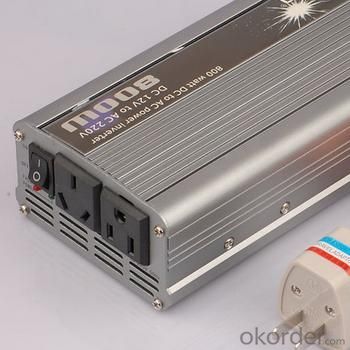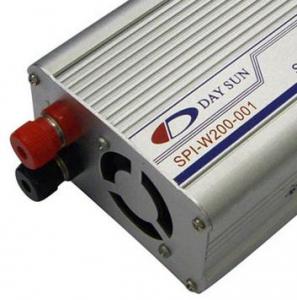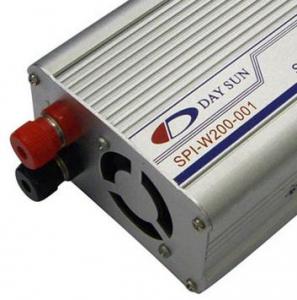Solar Controller Charge Useful High Qulity Nice Discharge 10A 12V
- Loading Port:
- China main port
- Payment Terms:
- TT or LC
- Min Order Qty:
- 100 unit
- Supply Capability:
- 10000 unit/month
OKorder Service Pledge
OKorder Financial Service
You Might Also Like
1, Product desciption
Inverter circuits designed to produce a variable output voltage range are often used within motor speed controllers.
The DC power for the inverter section can be derived from a normal AC wall outlet or some other source. Control and feedback circuitry is used to adjust the final output of the inverter section which will ultimately determine the speed of the motor operating under its mechanical load.
Motor speed control needs are numerous and include things like: industrial motor driven equipment, electric vehicles, rail transport systems, and power tools. (See related: variable-frequency drive ) Switching states are developed for positive, negative and zero voltages as per the patterns given in the switching Table.
The generated gate pulses are given to each switch in accordance with the developed pattern and thus the output is obtained.
2, Features of the product
Inverters convert low frequency main AC power to higher frequency for use in induction heating.
To do this, AC power is first rectified to provide DC power. The inverter then changes the DC power to high frequency AC power. Due to the reduction in the number of DC Sources employed, the structure becomes more reliable and the output voltage has higher resolution due to an increase in the number of steps so that the reference sinusoidal voltage can be better achieved.
This configuration has recently become very popular in AC power supply and adjustable speed drive applications. This new inverter can avoid extra clamping diodes or voltage balancing capacitors. There are three kinds of level shifted modulation techniques, namely:
The first thing to figure out is the length of road in need of street lights.
This can be a small entrance road only a couple hundred of feet long to miles of streets through an area. Does the area currently have any type of lighting available.
What is the reason for needing street lights in this area
Is the electrical grid already nearby or would you need to call in the power company to bring in electrical lines.
If the electric needs to be brought to the area, how much is this going to cost? Depending on how far the grid electric is from the location of the needed lighting, this can be quite expensive.
How much lighting is needed on the street? Do the lights need to be dark sky compliant.
Do the street lights need to run from dusk to dawn or for only a specified number of hours at night.
Are the street lights able to dim in the middle of the night and still provide enough lighting.
These questions need to be answered before you can decide on how many lights you will need to complete the project.
3, Detailed Specification
ltem | Description |
Rating Voltage | 1000VDC |
Rating Current | 15A |
Protection Class | CLASSll |
Ambien e Range:t Temperatur | -40℃---85 |
Dust,water level | IP67 |
Sealing | Closed |
Cable Specification | 4mm2 |
Dimension | 104x95x19(mm) |
Certification | TUV/ |
Diode model | SB4040LDC |
Testing standard | BS EN50548;2011 |
Pollution levels | 2 |
Maximum working temperature | 110℃ |
Flame retardant grade | UL94 V-0 |
Bus width | MAX.6.0 mm |
Convergence with the connection | Clamping |
Connector | CABLE |
4, Product Image

- Q:Can a solar controller be used with different types of batteries?
- Yes, a solar controller can be used with different types of batteries. However, it is important to ensure that the solar controller is compatible with the specific type of battery being used in order to optimize charging and prevent damage to the battery.
- Q:What is the maximum discharge current a solar controller can handle?
- The maximum discharge current a solar controller can handle depends on the specific model and its capabilities. It typically ranges from 10 to 60 amps for most residential and small-scale solar systems. However, larger commercial or industrial solar systems may have controllers that can handle higher discharge currents. It is important to refer to the specifications provided by the manufacturer to determine the maximum discharge current for a particular solar controller.
- Q:Can a solar controller be used with solar panel ground mounts?
- Yes, a solar controller can be used with solar panel ground mounts. A solar controller is essential for regulating the charge and preventing overcharging of batteries connected to solar panels. Regardless of whether the solar panels are mounted on rooftops or ground mounts, a solar controller ensures efficient and safe operation of the solar power system.
- Q:How does a solar controller handle battery temperature monitoring and protection?
- A solar controller handles battery temperature monitoring and protection by constantly monitoring the temperature of the battery. This is typically done by using a built-in temperature sensor or by connecting an external temperature sensor to the controller. The controller measures the temperature of the battery and compares it to a predefined temperature range. If the temperature falls outside of this range, the controller takes appropriate actions to protect the battery. If the temperature exceeds the upper limit, the controller may reduce the charging current or completely disconnect the solar panels from the battery to prevent overcharging and potential damage. This is important because high temperatures can lead to accelerated battery aging and reduced battery life. On the other hand, if the temperature drops below the lower limit, the controller may adjust the charging voltage to prevent undercharging. Cold temperatures can significantly affect the battery's performance and capacity, so it is crucial to ensure proper charging in such conditions. In addition to these protective measures, some advanced solar controllers may also offer temperature compensation. They adjust the charging parameters based on the battery temperature to optimize charging efficiency and prolong battery life. This compensation is particularly valuable as it helps to counteract the temperature-related variations in battery chemistry and performance. Overall, through continuous temperature monitoring and appropriate protective actions, a solar controller ensures that the battery operates within a safe temperature range, maximizing its lifespan and optimizing its performance.
- Q:Can a solar controller be used in conjunction with a solar inverter?
- Yes, a solar controller can be used in conjunction with a solar inverter. The solar controller helps regulate and optimize the power output from the solar panels, while the solar inverter converts the DC power generated by the panels into AC power that can be used in homes or businesses. Together, they work to efficiently harness and convert solar energy for various applications.
- Q:Can a solar controller be used with solar panels that are mounted in different orientations (e.g., horizontal, vertical)?
- Yes, a solar controller can be used with solar panels that are mounted in different orientations. The solar controller's primary function is to regulate and optimize the charging of the batteries connected to the solar panels. It does not depend on the orientation of the panels. However, it is important to note that the efficiency of the solar panels may vary depending on their orientation, which can affect the overall performance of the solar power system.
- Q:How do you determine the charging parameters for a solar controller?
- When determining the charging parameters for a solar controller, several important factors need to be taken into consideration. First and foremost, the type of battery being used must be determined. Different battery types, such as lead-acid or lithium-ion, have varying charging requirements. Each battery type has its own specific voltage range and recommended charging current. It is crucial to consult the manufacturer's specifications for your battery to guarantee safe and optimal charging. Next, the specifications of the solar panels should be considered. Solar panels have a maximum power rating, which indicates the amount of power they can generate under ideal conditions. It is important to ensure that the solar controller you choose can handle the maximum voltage and current output of your specific solar panel. Furthermore, the system voltage must be taken into account. The system voltage is determined by the overall setup of your solar power system, including the battery bank, solar panels, and other components. Common system voltages include 12V, 24V, or 48V. The selected solar controller must be compatible with the system voltage to ensure efficient charging. It is also essential to consider the desired charging algorithm. Solar controllers offer different charging algorithms, such as pulse width modulation (PWM) or maximum power point tracking (MPPT). PWM controllers are simpler and more cost-effective, while MPPT controllers are more advanced and can maximize the power output of the solar panels. The choice of charging algorithm depends on individual needs and budget. Lastly, any specific requirements or features should be taken into account. Some solar controllers offer additional functionalities such as temperature compensation, which adjusts the charging parameters based on the battery temperature. This feature can optimize charging efficiency and extend battery life. Overall, determining the charging parameters for a solar controller involves considering the battery type, solar panel specifications, system voltage, desired charging algorithm, and any specific requirements or features. It is crucial to thoroughly review the manufacturer's guidelines and specifications to ensure proper and efficient charging of your solar power system.
- Q:Can a solar controller be used with PWM (Pulse Width Modulation) technology?
- Yes, a solar controller can be used with PWM (Pulse Width Modulation) technology. PWM technology is commonly used in solar charge controllers to regulate the charging of batteries by varying the width of the charging pulses. This helps to maintain a steady and efficient charging process, extending the lifespan of the batteries.
- Q:How does a solar controller protect batteries from deep discharge?
- A solar controller protects batteries from deep discharge by continuously monitoring the battery voltage and cutting off the charging current when it reaches a certain low level. This prevents the batteries from being over-discharged, which can cause irreversible damage and reduce their lifespan.
- Q:Can a solar controller be used with a solar-powered food processing facility?
- Yes, a solar controller can be used with a solar-powered food processing facility. A solar controller helps regulate and optimize the charging and discharging of batteries in a solar power system, ensuring efficient utilization of solar energy. This is crucial for a food processing facility as it requires a reliable and uninterrupted power supply. By using a solar controller, the facility can effectively manage and store solar energy to meet its power demands, making it a suitable choice for a solar-powered food processing facility.
1. Manufacturer Overview |
|
|---|---|
| Location | |
| Year Established | |
| Annual Output Value | |
| Main Markets | |
| Company Certifications | |
2. Manufacturer Certificates |
|
|---|---|
| a) Certification Name | |
| Range | |
| Reference | |
| Validity Period | |
3. Manufacturer Capability |
|
|---|---|
| a)Trade Capacity | |
| Nearest Port | |
| Export Percentage | |
| No.of Employees in Trade Department | |
| Language Spoken: | |
| b)Factory Information | |
| Factory Size: | |
| No. of Production Lines | |
| Contract Manufacturing | |
| Product Price Range | |
Send your message to us
Solar Controller Charge Useful High Qulity Nice Discharge 10A 12V
- Loading Port:
- China main port
- Payment Terms:
- TT or LC
- Min Order Qty:
- 100 unit
- Supply Capability:
- 10000 unit/month
OKorder Service Pledge
OKorder Financial Service
Similar products
New products
Hot products
Hot Searches
Related keywords































